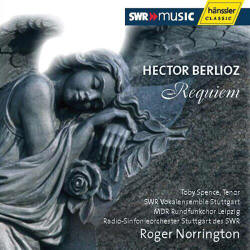|
You are reading the older HTML site
Positive Feedback
ISSUE
26
Berlioz's Requiem on SACD
Hector Berlioz (1803-1869) was one of the great composers whose fame, like that of Respighi, was based on revolutionary orchestration. Both composers stretched the orchestral palette like no one before them, and the Requiem of Hector Berlioz is a rather fine example. Many composers wrote requiems, with perhaps the requiems from Mozart (unfinished) and Verdi sharing the "top" spot. However, for sheer drama and emotion, the Berlioz Requiem will always be supreme. Throughout the history of classical music, there have been a few premiers of pieces that caused some serious emotional issues: the opening night of Stravinsky’s The Rite of Spring caused riots to break out. While Berlioz’s Requiem caused no riots, we do know that one poor chorus member suffered a nervous breakdown and by the conclusion of the funeral for General Damrémont, (the movements were performed in order of the funeral mass), the chief priest of the Dôme des Invalides was reduced to a sobbing wreck while embracing Berlioz! Perhaps it would be proper to mention who General Damrémont is. This person died while his army tried to take the Algerian city of Constantine: enough of the history lesson. The recording reviewed here is a new performance from Roger Norrington and the Radio-Sinfonieorchester Stuttgart des SWR on the Hänssler Classics label. I bought this SACD because I was always a fan of the work of Norrington back in his days with the London Classical Players. While he always displayed a commanding performance knowledge with the period ensembles (not the period ensembles that were typical for baroque and renaissance styles), the new SACD shows that he is master of modern ensembles as well. I am not going to offer a blow-by-blow description of the 10 individual movements. Rather, simply highlight those movements that are inspirational. Please note that this does not imply the other movements to be lacking in any way. I will say that I own two other SACD recordings of the Berlioz Requiem: Spano/Atlanta/Telarc and Munch/Boston/Living Stereo. Dies irae: Way back when I first heard the Berlioz Requiem this was the selection used by my friend who was going to prove to me that yes there is such as a piece that features 4 antiphonal brass choirs and numerous timpani players. That was an old Phillips LP with Colin Davis and the LSO. Yes, I was impressed. However, that was NOTHING compared to what I heard on the Hänssler! Stunning brass with little apparent "palm policing" from the conductor. Terrifying brass and percussion and the feeling like the world is truly ending. Norrington’s tempi are overall similar to the other two, though at one point Norrington kicks the tempo. Both the Norrington and Spano recordings do suffer some very slight phasing issues with the massed brass groups, but that is quite forgivable, thank you very much. Rex tremendae: Another very exciting movement. Special kudos to the choirs as this movement lets them really shine without having to compete with the brass. The choirs here have excellent control, not unlike the precision that Robert Shaw obtained with is chorus in Atlanta. VERY clean sibilants! Of course, the orchestra and especially the brass are not ignored. VERY top notch. Lacrymosa: This movement created a crisis - not whether I liked the performance, but rather, will I now keep the Telarc? It was this movement that made me sadly realize that the Spano recording was down right dull. What happened? Well, just listen to the interplay between the orchestra (brass) and chorus on the Norrington…then listen to the Spano….no comparison. The Norrington is vivid, exciting, dramatic….the Spano, barely limp, is saved only by the chorus. Enough said. Sanctus: Ah, the piece de resistance! Lovely, heart warming, divine with the totally angelic yet manly singing of Toby Spence. This touching movement sealed the deal on this recording. We need more recordings of this wonderful tenor! Does the world need another recording of Berlioz’s Requiem? Do you need another recording? Do I need another one? Well, that is easy! As mentioned, I already own two other SACD recordings of this piece. However, this recording offers more in sheer drama, palpable emotion, excitement, passion, and angst than either the Spano/Atlanta or the Munch/Boston offers. After listening to these recordings, I am now only going to keep the Spano because I like the ASO Chorus. The Munch/Boston will definitely stay in the library as it still offers a good deal of enthusiasm as well as quality playing and singing. Then again I will confess to be a person who, when finding a piece that I like, will own many different recordings of the same piece. For instance, I own 14 recordings of Mahler’s 5th Symphony. In closing, I have only praise for this recording. This is a live recording and I must offer some praise for the very quite audience. What is interesting is the picture of the orchestra that is included in the booklet: if this is the hall where this music was recorded, then I suspect that the hall is somewhat smaller than one might expect for a piece of this magnitude. My comments on the apparent size of the hall are in no way intended as a negative. The sound over all is immediate though not too closely miked. I hate to pile on the numerous audio-adjectives (space, air, etc) but I will say that the sound is top notch and the engineers captured a spacious feel and overall excellent warmth! An extremely satisfactory first purchase of a Hänssler SACD, and certainly not my last. Enjoy…
|

